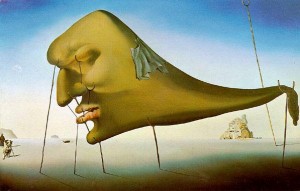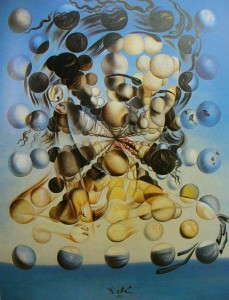Scientists think that Time is Natures way to avoid that Everything happens or happened at once. Time puts everything in a causal sequence.
The big question is if we are traveling the only possible sequence. Is it possible to connect events the way we want them to be connected?
It looks like that the answer is Yes. We are able to travel time.
Time slows down when we are relaxed and speeds up when we are active. The past moves much more slowly as the present.
Only a few moments or events stay in our active memory and the distance between these events widens when we get older.
When we move back in time or jump one level higher in abstraction the Universe is made more compact, more essential. Perhaps there is one essential structure behind everything.
When we move back in time history seams to repeat itself.
Perhaps the essential structure looks like a circle or a topological variant of a circle, a manifold.
Time moves with different speeds at different levels. Perhaps Events are real and Time is a construction, an Ilusion.
According to Physicists the Time-Line is not a chain but a network of possible lines and it is not clear that the Time-Lines that we Choose are the only time-lines that are realized.
I emphazise the word Choose because Chosing is perhaps an Act of Creation that generates multiple time-lines in which we are divided into parts that are still connected in a whole.
It is possible that every time events takes place we are spit up in many parts that move with every possibility to the future. If this is true there are not only many futures but also many pasts (and many Alter Ego’s).
The possible futures are called multi-verses. For some reason we are not able to connect to our fellow-travellers united in our joint Whole.
A veil is seperating us but ik looks like the veil (of Isis) will be lifted and we will know all our soul-mates in the past, present and future.
Some Physicists imagine there is no time at all. The Universe is a static structure of immense beauty.
Time is an illusion. We (our Senses) are creating this illusion. We are really watching a multidimensional movie and the movie is stored in the Universe (The Akasha).
If this is true The Now, The Past en the Future are already there.
If the Universe is really static and we are the Observers of the Universe the issue of Physics is brought back to solving the problem of the way the data is Stored.
“To see a World in a Grain of Sand And a Heaven in a Wild Flower
Hold Infinity in the palm of your hand And Eternity in an hour”.
The first lines of William’s Blake poem “Auguries of Innocence” describe what is known in Physics as the Holographic Principle.
All the data to compute the actions of our Universe is stored at the surface of a manifold. In physics this manifold can be a very complicated structure, a geometry.
In our world the manifold is often a rotating device (disk, tape). The rotating device is “scanned” and the data is transformed in a signal. At this moment almost all the storage is digital (bits).
A Hologram is created when the reflection-pattern of the beam of light of a laser is aimed a a 3 Dim-Image. The pattern is stored on a 2Dim-surface.
A Hologram has a very special property. A part of the Hologram contains the data of the whole. When parts of the Hologram are used they produce the same image with a lower quality (!!!).
A “grain of sand” could contain the complete image of the Universe but if the grain was a part of a bigger picture the image of the Universe would be very vague. Only if the grain contains the complete structure of the Whole is would show Every Thing.
The “Part produces the Whole”-principle of the Hologram has exited many people. It has produced a mystic theory of Physics that is supported by David Bohm, one of the pupils of Einstein. Later the idea of a Hologram was promoted by Karl Priham to Explain the Brain.
To distinguish the two Holographic principles the last one is called the Strong Holographics principle.
The Holographic Principle is derived out of the correspondence between the Information theory of Claude Shannon and the theory of Boltzmann. Both have created a theory about the concept Entropy.
Entropy is a measure of the structure (or chaos) of a system. Structure turns into chaos when there is no influx of energy. A living system is an example of a system that maintains its structure by the intake of energy (food, air). It reconstructs his structure by permanently replacing the damaged parts (Autopoiesis).
The big difference between the theories of Bolzmann and Shannon is that the Information theory of Shannon is dimensionless. Everything is just bits. When the bits are scanned they (re-)produce the picture (or the sound).
The Holographic principle shows that it is possible to imagine a Universe where the data that is stored in a n-Dimensional surface is able to create a n+1-Dimensional (or n+j j>1) universe. The Universe could be stored in a grain of sand.
The dynamics in the Universe is created by the deepest layer the Vacuum. On the very small level of the Vacuum there is only chaos. This chaos is a result of the Heisenberg uncertainty principle.
The chaos of the Vacuum or the Zero-Point-Field generates an enormous amount of potential energy that flows through possible paths (Spin-networks). The temperature of the vacuum is so high that the water that flows through the networks changes into a foam (Spin-foam).
On the deepest level the Universe can be represented as a constant creation and destruction of tiny Soap-bubbles that contain an enormous amount of potential energy. Someone or something has to guide this energy through all the possible pathways that are described by the Magic Hologram.
Just like Julian Barbour in his book “The End of Time“, Michael Lockwood takes the Now very seriously.
In his recent book The Labyrinth in Time he calls the Now Actuality. Actuality is a part of the surface of the Hologram that we (the Sensors, The Observers) are traveling. We are able to move back and forth at the surface. This means that we are able to travel time. The only condition we have to fullfill is that we are closing the loop. We have to close the loop because in the end we always arrive at the beginning.
The Universe is an eternal cycle of expanding and contracting states (The Big Bounce). Loop Quantum Gravity has been able to solve the problem of what happened before the Big Bang. It is also a result of the Holographic principle.
The father of the Holographic principle is John Archibald Wheeler.
He believes we create the Universe through quantum-mechanical acts of observation, a process he calls “genesis by observership”. “The past is theory,” he once wrote. “It has no existence except in the records of the present. We are participators, at the microscopic level, in making that past, as well as the present and the future.”
 The Causal, Linear, chain of Time as a Flow is an Illusion.
The Causal, Linear, chain of Time as a Flow is an Illusion. We, the Humans, are “more conscious” than the Universe because we have a faculty called a Will.
We, the Humans, are “more conscious” than the Universe because we have a faculty called a Will. Perhaps we are different because we Live. The Universe (Matter) is dead.
Perhaps we are different because we Live. The Universe (Matter) is dead. In our context we have a Free Choice (not free Will) to travel one of the many (246 * 320 * 59 * 76 * 112 * 133 * 17 * 19 * 23 * 29 * 31 * 41 * 47 * 59 * 71) paths the Universe has made available for us to explore.
In our context we have a Free Choice (not free Will) to travel one of the many (246 * 320 * 59 * 76 * 112 * 133 * 17 * 19 * 23 * 29 * 31 * 41 * 47 * 59 * 71) paths the Universe has made available for us to explore. 



